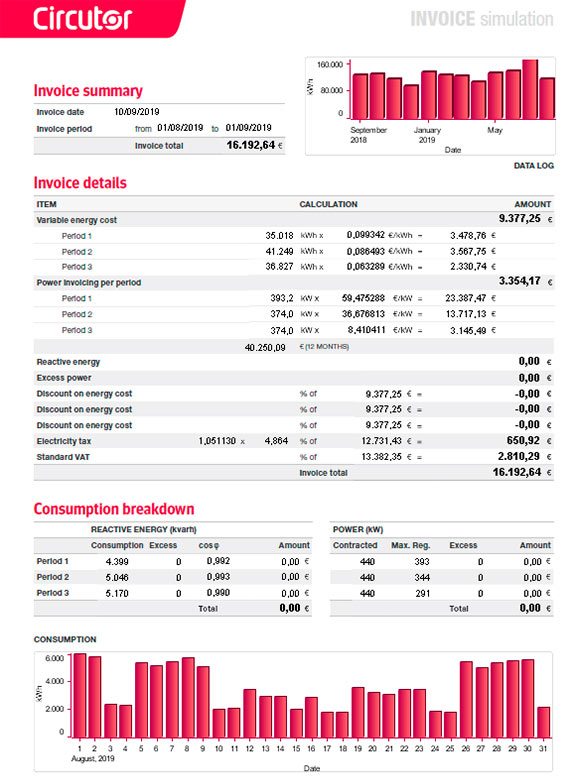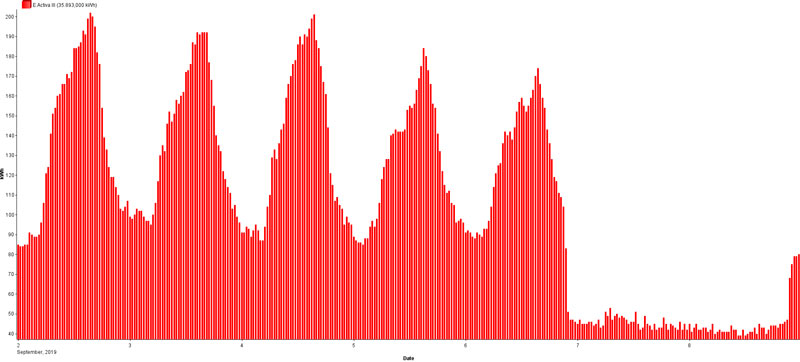The three components of this system are: measurement devices, communication network, and software application. According to a MIT study, buildings waste at least 30% of their energy, and because of this, the main objective of this system is to do analysis on energy efficiency and to reduce energy consumption.
To understand the benefits of an energy management system, it is important to know that energy management is based on 5 fundamental aspects: how much, where, when, what, and how.
Firstly, how much energy is consumed, this is important to compare to identify billing errors. By being able to obtain power and energy charts, users are able to see whether energy costs in bills are accurate or not. Furthermore, the users will be able to detect if the contracted power of their installations are correctly defined. If the contracted power is much higher than the maximum consumption, the user can change the contract with the utility and this will directly decrease the bill value at the end of the month.

Energy bill simulation
Secondly, when is the energy consumed, this is important as there are peak hours and off peak hours. Identifying billing errors aside, this is beneficial as atypical consumptions can easily be detected and identified. By detecting these consumptions, wasted energy can be managed and reduced by managing loads. Therefore, “atypical consumptions” can be detected by knowing when the energy is consumed. This means that there are consumptions in the installations that should not exist in the hours in which they occur. This is because we do not have control of all the loads of the installation, so a scada system that records the consumption of the entire plant will helps us to detect and eliminate them.
 Weekly energy chart
Weekly energy chart
Where is energy consumed is a big part of this system as this allows users to see how much energy is used for air conditioning, lighting, computer servers, etc. So information on energy consumption can be compared by installation, zone, or uses. This also goes along with the idea of allocating costs in a monetary value in order to forecast costs. Potential savings can also be detected.
This type of management is very important when establishing the objectives for the implementation of the ISO 50001 Energy Management System, as the areas or lines with the largest consumptions will be those in which energy improvement tasks will first be focused on.

Consumptions compared by areas and uses
How do I pay for energy? With the existing tariffs, the energy management system allows users to manage working hours in order to achieve optimum savings, for example: allocating more energy consumption to be used during the non-peak hours would allow companies to use the same amount of energy at a lower cost. Secondly, the information provided by the system allows users to manage the power factor through capacitor banks in order to avoid penalties. Similarly, the system also can help calculate the power demand needed to avoid overestimating and wasting money through fixed costs or going over the maximum power demand and getting a penalty.

Reactive energy and Maximum Demand breakdown
Finally, what is the network quality of the installation? As harmonics tend to disrupt electrical systems, with the energy management system and filters, maintenance is prevented. An example of a problem caused by harmonics is loss of performance. Because of the distortions, the performance of electrical motors are degrading, to add to that, interferences occur in communications and control systems. Another example is the ability to trip electrical protections, this applies not only to circuit breakers but also earth leakage protection. This is important because by improving the network quality of the installations, companies are avoiding unwanted protection trips, therefore leading to more productivity. This system also enables users to be alert when an error comes up through alarms.
In conclusion, with the Energy Management System, companies are more competitive as costs are reduced; companies are more efficient as maintenance is prevented and strategic decisions are performed. As sustainability is an important goal these days, especially in Indonesia, with never ending devastating forest fires spread across the islands of Sumatra, Kalimantan, and Riau as well as a heavily polluted capital city. This system allows a reduction in carbon footprint and unnecessary energy waste, as factories are heavily dependent on fossil fuels. Overall, not only does the energy management system provide real-time information on energy consumption; it helps reducing expenses through utility bills and performance is boosted as well.
Written by: Anastasia Annelie Limputra

WRITTEN BY CIRCUTOR